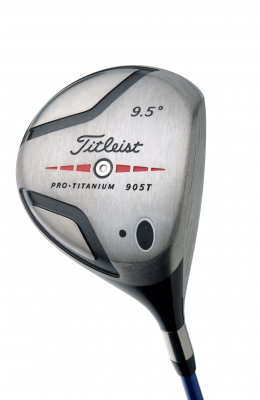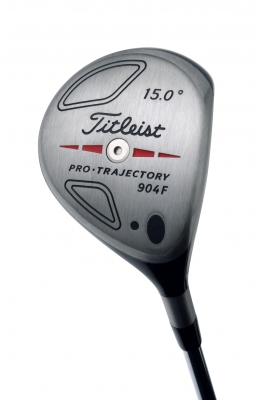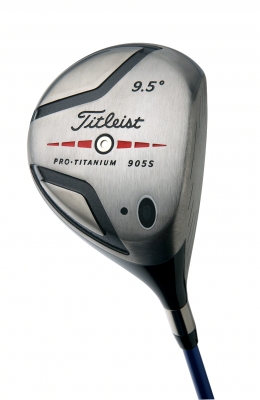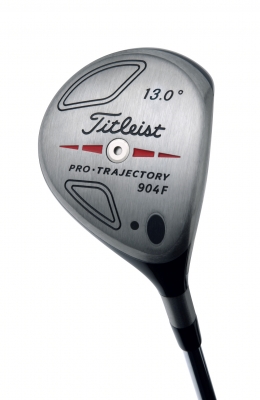By Jeffrey A. Rendall, Images Courtesy of Titleist
|
|
FAIRHAVEN, MA – When looking at Titleist’s 2005 line-up of ‘new’ golf balls, we theorized that a golf equipment manufacturer would never say ‘It doesn’t get any better than this.’
Because if that were the case, they’d never be able to introduce new products -- since logically, the ones that are currently on the market could never be improved upon.
The same rationale goes for Titleist’s latest offerings in the metal wood categories, the 905 line of Drivers, and the 904 Fairway Metal Woods. The 905 drivers, with different model choices 905S and 905T, replace the 983 K and E clubs, introduced just two years ago (2003). The 983 drivers were the successors to the highly successful 975 models, the first of which were brought out in 1997.
With so little turnover time (though in fairness, many other companies are producing new drivers fast enough to make your head spin), was it possible to impart that much new benefit into the clubs?
Jeff Meyer, Titleist’s Director of Metal Wood Development, says that despite only a short lag time between the two series’ introductions, the new 905 clubs are indeed, ‘new and improved.’
“There are several new features and benefits to the new 905 drivers – but from a performance standpoint, the primary differences as compared to the 983 line stem from the volume of the head and the location of the center-of-gravity. The volumes on the 983E and K are 350cc and 365cc respectively – and the new 905S and T drivers are a bit bigger at 395cc and 405cc, respectively,” Meyer said.
 |
| The Titleist 905T Driver is slightly larger than the S version. |
He continues, “Likewise, the center-of-gravity (cg) is lower for the new drivers, which promotes a higher launch angle and a lower backspin rate, resulting in an increase in maximum distance. Some of the extra weight used to optimize the cg location came from removing weight from the titanium hosel tube and replacing it with a lower density aluminum alloy – while still maintaining the feel and performance of a bore-through design.”
Don’t you just love it when they bring in the science part? My father the engineer would certainly understand what it all means, but I think Meyer’s basically saying that these are mathematically superior to the ‘old’ clubs.
“The increase in club head volume also resulted in an increased rotational inertia, which produces higher ball speeds on off-center impacts,” Meyer added.
Bingo! The new clubs add distance, and are more forgiving. How do they do it? Improved materials and computer generated locations for weight distribution. One can only picture the engineers tinkering with the different alloys and head configurations, and some are better than others. Who benefits? You and me.
There’re even some differences within the two 905 models – the 905S launches the ball lower and spins less than the 905T, due to its head geometry, deeper face and more forward cg location.
The 905 models’ cg is more neutrally located in the head, whereas the 983K was a little heel-biased, and the 983E was a little toe-biased. Therefore, the 983E had some right-side tendencies, and the 983K would favor the left side (for us slicers). Not so with the 905 models, where it’s more of an even proposition.
“Relative to the 983E and K, the new drivers will launch the ball approximately 0.50 degrees higher and spin about 400 rpm less,” Meyer said. So, in essence, the ball goes higher and flies straighter. Small improvements, but still advanced from a few years ago.
 |
| The new Titleist 904F Fairway Woods -- easier to hit than its predecessors. |
One curious thing about the 905 clubs, as compared with the popular trend these days, was the fact they didn’t go jumbo like a lot of new drivers, up to the maximum allowable head size, 460cc’s of volume.
Meyer says it’s because their target audience didn’t like the clanky sound produced by the big heads. Because of weight considerations, the biggest heads’ walls must be made thinner, which emits a loud softball bat-like sound when you hit them. For those who’ve played with a partner using one of the big 460cc drivers, you know what I’m saying.
Meyer said there was more than just the sound of the club that kept them from going ‘bigger.’ “We have designed and evaluated numerous 460cc drivers, but found that at that volume, there isn’t enough discretionary weight to optimize the cg location. Plus, our target audience preferred playing drivers at volumes around 400cc’s. Even though Tiger Woods and Vijay Singh have switched to the 460cc drivers, the overwhelming majority of drivers on the PGA Tour are still around 400cc’s – last time I checked, it was over 90%.”
“Also, as you make larger volume drivers, the cg had a tendency to move towards the clubface. In an effort to combat this forward cg location, most manufacturers will close the face angle. Our target audience didn’t like the appearance of a closed golf club – we have not produced one, and continue to set our face angles square,” Meyer added.
Some of us tend to take the club back a little closed anyway, and if your mind thinks it’s going hot left, it’s probably going that way – or you compensate and block it big-time right. Here’s one for preferring the square face at address.
All things considered, will buying the 905 give you more distance?
Again, Meyer supplies the answer. “The only way to get more distance out of a driver is to produce one that launches higher and spins less. So basically, with the 905 clubs we’ve created a center of gravity location that’s going to do that. What we’ve found in our testing is – if properly fitted – you’re going to gain approximately five yards over the older clubs.”
 |
| Reduced Spin and a higher launch angle -- the improvements in the 905S from the earlier 983 models. |
Specialization – it was the theme for golf balls, and it’s the theme for drivers… or any other club in golf. Face it, you are what you are, and the equipment is moving ever further in the direction of ensuring you get the yards your swing will allow you.
With all the focus on the ‘big dog’ these days, people tend to forget the next biggest clubs in their bags, fairway woods (or as TV commentators are fond of saying, ‘fairway metals’). Some people love ‘em, others can’t stand ‘em. The true iron player would rather have a two-iron, which is the way I’ve always been in the past.
But honestly speaking, the 904F fairway woods are changing my mind.
Meyer tells how they depart from the previous generation: “The center-of-gravity location and modified shape are the primary differences between the older 980F and the new 904F fairway woods. The 904F’s have a cg that’s been designed to be lower, forward and further from the shaft axis. This shift in cg has created a family of fairway woods that launch higher, spin less, reduce dynamic face closure, and have an increase in ball speed on center as well as off-center impacts.”
He continues, “The sole design is very traditional – it was pulled down in the heel and toe areas, creating more face area for more forgiving shots on off-center impacts.”
Whatever it is, there’s a noticeable difference from the older models – both off the fairway and off the tee. We’re always reluctant to outright endorse anything, but these clubs are easy to hit and consistent. That’s not saying there aren’t other great fairway wood alternatives, just that we really enjoyed these particular designs.
They’re great off the tee and from tight fairway lies. Meyer says they’re designed for both, in a 50-50 proposition. “Again, we’ve kind of pulled down the toe and heel area, so there’s more face area. This is great for using the 904F off the tee, but also from your more expected fairway situations. We’ve done a lot of research and studying, and we think these clubs are really done well.”
 |
| Tee up the 904F 13 degree model -- and it'll give you as much distance as many drivers. |
We agree. The 905 drivers also deserve a thumbs-up, though we’ll suggest that before you invest the money into a new driver, that you hit them all first. Meyer admits that there are a lot of good products on the market, and it really comes down to what looks good to you – along with the proper fitting exercises that are so necessary with all this club/ball specialization.
Here’s to playing a good while with the current generation of clubs and golf balls, always with an eye towards the future for what’s coming next around the corner.
Details:
The Titleist 905 Drivers and 904F Fairway Woods
Available at your higher-end golf retailers and club pro shops.
| Related Links | Comments on this article? | |
|
Maryland National Golf Club Hollow Creek Golf Club Rocky Gap Resort PB Dye Golf Club in Ijamsville Whiskey Creek Golf Club |
E-mail Jeff Rendall, Editor: jrendall@golftheunitedstates.com |












